Germany

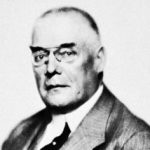 The process of trying to end a war and bring peace between nations is a tricky one, and one that can end up being highly volatile, or even explode into further fighting!! The world was in the midst of World War I, and an armistice had been signed between Russia and Germany. The Soviet government had requested peace negotiations on Nov. 8, 1917. They began on December 22, 1917, nearly three weeks after a ceasefire was declared on the Eastern Front. Representatives of the two countries began peace negotiations at Brest-Litovsk, near the Polish border in what is now the city of Brest, in Belarus. They were divided into several sessions. During this time, the Soviet delegation tried to prolong the proceedings, so they could take full advantage of the opportunity to issue propaganda statements. Meanwhile, the Germans grew increasingly impatient with the delays.
The process of trying to end a war and bring peace between nations is a tricky one, and one that can end up being highly volatile, or even explode into further fighting!! The world was in the midst of World War I, and an armistice had been signed between Russia and Germany. The Soviet government had requested peace negotiations on Nov. 8, 1917. They began on December 22, 1917, nearly three weeks after a ceasefire was declared on the Eastern Front. Representatives of the two countries began peace negotiations at Brest-Litovsk, near the Polish border in what is now the city of Brest, in Belarus. They were divided into several sessions. During this time, the Soviet delegation tried to prolong the proceedings, so they could take full advantage of the opportunity to issue propaganda statements. Meanwhile, the Germans grew increasingly impatient with the delays.
The leader of the Russian delegation was Leon Trotsky, the Bolshevik People’s Commissar for Foreign Relations. Max Hoffmann, the commander of German forces on the Eastern Front, served as one of the chief negotiators on the German side. The main difference of opinion in Brest-Litovsk was over the surrender of Russian land to the Germans. The Russians demanded a peace agreement without annexations or indemnities and the Germans were unwilling to concede on this point. In February 1918, Trotsky announced he was withdrawing the Russians from the peace talks, and the war was on again. This would turn out to be one of the biggest, if no the biggest mistake of his career.
With the renewal of fighting, the Central Powers quickly took the upper hand. In a way, it was Russia against the world, and Russia was not likely to win that one. The Central Powers quickly seized control of most of Ukraine and Belarus. The Bolshevik hope that the workers of Germany and Austria, offended by their governments’ obvious territorial ambition, would rise up in rebellion in the name of the international working class people, soon vanished. Russia was fighting a losing battle, and they would have to surrender in the end.
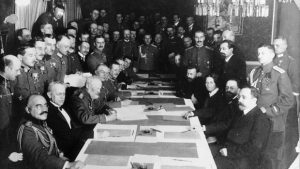
The end came on March 3, 1918, when Russia accepted peace terms that were even more harsh than those originally suggested by Germany. Russia would lose Poland, Lithuania, and the Baltic states of Estonia, Livonia, and Courland to Germany. To further devastate Russia’s hopes, Finland and the Ukraine saw Russia’s weakness as an opportunity to declare their independence. In all, Brest-Litovsk deprived Lenin’s new state of one million square miles of territory and one-third of its population, about 55 million people. Sometimes, it’s better to settle, rather than risk a loss far more devastating.
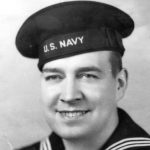 When we think of the name Hitler, most of us think of the vicious dictator who was responsible for the slaughter of as many a 6 million Jewish people, not to mention all the other people he killed in his crazed state of mind. For most of us, hearing the name Hitler brings with it feelings of horror, disgust, and continued shock every time we learn a new fact about Hitler and his Third Reich. Yes, the name Hitler doesn’t usually bring any feelings of…anything good. Well, what I learned today, changed my view of that. You see, not everyone named Hitler was evil, not even everyone named Hitler during World War II, and not even everyone who had the unfortunate…misfortune of being related to Adolf Hitler. You see, for William Patrick Hitler of Liverpool, England, having the name wasn’t the worst part of his situation. William was actually the nephew of Adolf Hitler, the Führer of Nazi Germany. It was a reality that made him almost nauseous. Dealing with that reality would take William on a zigzag path leading to Germany, England, America, and finally the United States Navy. I’m sure that you, like me, thought, “How could the United States Navy allow a nephew of Adolf Hitler to join up, much less to muster out with men sent to fight his uncle.
When we think of the name Hitler, most of us think of the vicious dictator who was responsible for the slaughter of as many a 6 million Jewish people, not to mention all the other people he killed in his crazed state of mind. For most of us, hearing the name Hitler brings with it feelings of horror, disgust, and continued shock every time we learn a new fact about Hitler and his Third Reich. Yes, the name Hitler doesn’t usually bring any feelings of…anything good. Well, what I learned today, changed my view of that. You see, not everyone named Hitler was evil, not even everyone named Hitler during World War II, and not even everyone who had the unfortunate…misfortune of being related to Adolf Hitler. You see, for William Patrick Hitler of Liverpool, England, having the name wasn’t the worst part of his situation. William was actually the nephew of Adolf Hitler, the Führer of Nazi Germany. It was a reality that made him almost nauseous. Dealing with that reality would take William on a zigzag path leading to Germany, England, America, and finally the United States Navy. I’m sure that you, like me, thought, “How could the United States Navy allow a nephew of Adolf Hitler to join up, much less to muster out with men sent to fight his uncle.
Born March 12, 1911, in Liverpool, England, William Hitler was the only child of Bridget Dowling and her Austrian expatriate husband, Alois Hitler Jr, who was the half-brother of Adolf Hitler. In 1914, Alois abandoned his wife and three year old son to go traveling through Europe. The outbreak of World War I prevented him from returning to England, so he settled down in Germany, married again, despite still being married to Dowling, and started a new family. For years, Alois made no attempt to contact his wife and son back in Liverpool, but rather had someone tell Dowling that he was dead. In 1924, the truth came out. Alois was charged with bigamy in Germany, but avoided conviction because Dowling actually interceded on his behalf. That was all she did however. She drew the line, when Alois asked her to send William to Germany for a visit. She told him that she would not let her son visit until he reached his 18th birthday, in 1929. Upon turning 18, William traveled to Germany and reconnected with his father, who took him to a Nazi rally where he saw his Uncle Adolf, leader of the rising National Socialist (Nazi) Party. William visited Germany again in 1930, this time  meeting his uncle in person and receiving an autographed photo from him.
meeting his uncle in person and receiving an autographed photo from him.
I’m sure that William thought that his relationship with his uncle would be something that would advance his journalism career, but Hitler didn’t want anyone to know what he was doing. William’s articles about his Uncle Adolf Hitler, only served to be the beginning of being blackballed from everything to do with Adolf Hitler, and his disgust with Adolf Hitler and his insane ways. Hitler called William to Berlin, and reportedly ordered him to retract the articles. Now William saw a totally different side of his uncle…describing it as a “wild-eyed and tearful” outburst. Apparently Hitler even threatened to kill himself if William ever again published anything about his personal life. Now, William became persona non grata in England. He was fired from his job in 1932. Unable to find other employment in his homeland, he decided to look for work in Germany. Perhaps his increasingly influential uncle could be persuaded to help, but no warm welcome awaited in Germany. According to William, whose July 4, 1939 article for Look magazine, “Why I Hate My Uncle,” is the sole source on his dealings with his uncle Adolf Hitler, who sent William a letter during his visit, denying they were relatives. Shortly afterward, William’s father sent him back to England. I guess he was persona non grata with his dad too.
William tried using his relationship to Hitler to obtain a job in Germany, and was successful, but when he tried to send money to his mother, he was informed that Hitler would not allow it…even for family. William began to see a much more evil side of his uncle. Eventually, he left Germany and went back to England, but found that he was not welcome there either. He and his mother moved to the United States, where his relationship again caused him problems. Finally, in 1942, William wrote directly to President Franklin D. Roosevelt, begging to be allowed to serve in the US military. “I am one of many, but can render service to this great cause,” he wrote. FDR passed the letter on to FBI Director J. Edgar Hoover, who looked into William’s background and finally cleared him for military service. Sworn into the US Navy in New York City on March 6, 1944, William Hitler went on to serve three years as a pharmacist’s mate, receiving the Purple Heart for a wound he suffered. He was 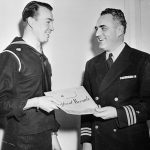 discharged in 1947.
discharged in 1947.
Finally tired of the attention his controversial surname attracted, William changed it to Stuart-Houston after returning to the civilian world. He married German-born Phyllis Jean-Jacques, and the couple settled in Patchogue on New York’s Long Island, where they had four children, the first of whom bore the surprising middle name of Adolf. William ran a blood analysis lab, Brookhaven Laboratories, in his family’s home. William Stuart-Houston died on July 14, 1987, and was buried next to his late mother in Coram, New York. His children did not produce any children of their own…and so ended the line.
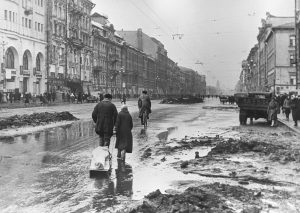 When an evil empire, such as Hitler’s regime in Nazi Germany, decides to rule the world, they begin to take over neighboring nations…by any means possible. If the nation is too weak to fight, it is easy, but if the nation can fight it becomes much harder to succeed. Nevertheless, they always seem to find a way, if they are determined enough. And Hitler was nothing, if not determined. The Nazis invaded the Soviet Union in late September, and surrounded Leningrad soon after. The months that followed, found the people of the city trying to establish supply lines from the Soviet interior and attempting to evacuate its citizens. It was a tough process and they often found themselves using a hazardous “ice and water road” across Lake Ladoga. A successful land corridor was finally created in January 1943, and the Red Army finally managed to drive off the Germans the following year. Nevertheless, all that took time, and in the end, the siege lasted nearly 900 days and resulted in the deaths of more than 1 million Soviet civilians.
When an evil empire, such as Hitler’s regime in Nazi Germany, decides to rule the world, they begin to take over neighboring nations…by any means possible. If the nation is too weak to fight, it is easy, but if the nation can fight it becomes much harder to succeed. Nevertheless, they always seem to find a way, if they are determined enough. And Hitler was nothing, if not determined. The Nazis invaded the Soviet Union in late September, and surrounded Leningrad soon after. The months that followed, found the people of the city trying to establish supply lines from the Soviet interior and attempting to evacuate its citizens. It was a tough process and they often found themselves using a hazardous “ice and water road” across Lake Ladoga. A successful land corridor was finally created in January 1943, and the Red Army finally managed to drive off the Germans the following year. Nevertheless, all that took time, and in the end, the siege lasted nearly 900 days and resulted in the deaths of more than 1 million Soviet civilians.
The German and Finnish forces besieged Lenin’s namesake city after their spectacular initial advance during Operation Barbarossa in the summer of 1941. Nevertheless, it was not going to be an easy task to bring the Soviet people into submission. A German Army Group struggled against stubborn Soviet resistance to isolate and seize the city before the onset of winter. The fighting was heaviest during August. German forces reached the city’s suburbs and the shores of Lake Ladoga, severing Soviet ground communications with the city. In 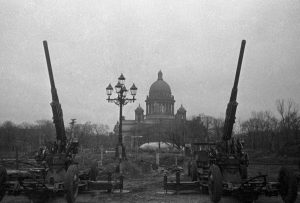 November 1941, Soviet forces repelled a renewed German offensive and clung to tenuous resupply routes across the frozen waters of Lake Ladoga. After that, German and Soviet strategic attention shifted to other more critical sectors of the Eastern Front, and Leningrad…its defending forces and its large civilian population…endured an 880 day siege of unparalleled severity and hardship. I simply can’t imagine the cruelty of a regime that would let a million people starve to death to obtain power. Despite desperate Soviet use of an “ice and water road” across Lake Ladoga to resupply its three million encircled soldiers and civilians and to evacuate one million civilians, over one million civilians perished during that bitter siege. Another 300,000 Soviet soldiers died defending the city or attempting to end the siege. In January 1943, Soviet forces opened a narrow land corridor into the city through which vital rations and supplies again flowed. But it was not until January 1944, that the Red Army successes in other front sectors enable the Soviets to end the siege. By this time, the besieging German forces were so weak that renewed Soviet attacks drove them away from the city and from Soviet soil. Determination simply wasn’t enough to win that victory for Hitler.
November 1941, Soviet forces repelled a renewed German offensive and clung to tenuous resupply routes across the frozen waters of Lake Ladoga. After that, German and Soviet strategic attention shifted to other more critical sectors of the Eastern Front, and Leningrad…its defending forces and its large civilian population…endured an 880 day siege of unparalleled severity and hardship. I simply can’t imagine the cruelty of a regime that would let a million people starve to death to obtain power. Despite desperate Soviet use of an “ice and water road” across Lake Ladoga to resupply its three million encircled soldiers and civilians and to evacuate one million civilians, over one million civilians perished during that bitter siege. Another 300,000 Soviet soldiers died defending the city or attempting to end the siege. In January 1943, Soviet forces opened a narrow land corridor into the city through which vital rations and supplies again flowed. But it was not until January 1944, that the Red Army successes in other front sectors enable the Soviets to end the siege. By this time, the besieging German forces were so weak that renewed Soviet attacks drove them away from the city and from Soviet soil. Determination simply wasn’t enough to win that victory for Hitler.
After November 1941, possession of Leningrad held only symbolic significance. In holding the “ice and water road” the Soviets were able to bring in enough supplies to stave of the ongoing starvation, so the siege has a 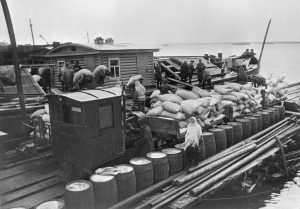 little less effect. The Germans maintained their siege with a single army, and defending Soviet forces numbered less than 15 percent of their total strength on the German-Soviet front. The Leningrad sector was clearly of secondary importance, and the Soviets raised the siege only after the fate of German arms had been decided in more critical front sectors. Despite its diminished strategic significance, the suffering and sacrifices of Leningrad’s dwindling population and defending forces inspired the Soviet war effort as a whole. No nation can lose that many people and not feel its impact. The siege ended on January 27, 1944, but I don’t think the people felt that it was such a big victory, considering the loss of life.
little less effect. The Germans maintained their siege with a single army, and defending Soviet forces numbered less than 15 percent of their total strength on the German-Soviet front. The Leningrad sector was clearly of secondary importance, and the Soviets raised the siege only after the fate of German arms had been decided in more critical front sectors. Despite its diminished strategic significance, the suffering and sacrifices of Leningrad’s dwindling population and defending forces inspired the Soviet war effort as a whole. No nation can lose that many people and not feel its impact. The siege ended on January 27, 1944, but I don’t think the people felt that it was such a big victory, considering the loss of life.
 In the 18th and 19th century, going swimming was not done in the same way as it was today. While it was considered ok to swim, the clothing was not considered appropriate, and so men and women were segregated during swimming. I don’t suppose going to the beach was as common, and so it problem might not have come up every day, but it came up enough to create a need for a “proper” way to accomplish an outing involving swimming. Enter the Bathing Machine. The bathing machine was basically a small room built on wheels that could be taken to the beach. People entered the machine while it was on the beach, wearing their street clothing. In the machine they changed into their bathing suit, although men were allowed to bathe nude until the 1860s. They then placed their street clothes into a raised compartment in the bathing machine, where they would remain safe and dry.
In the 18th and 19th century, going swimming was not done in the same way as it was today. While it was considered ok to swim, the clothing was not considered appropriate, and so men and women were segregated during swimming. I don’t suppose going to the beach was as common, and so it problem might not have come up every day, but it came up enough to create a need for a “proper” way to accomplish an outing involving swimming. Enter the Bathing Machine. The bathing machine was basically a small room built on wheels that could be taken to the beach. People entered the machine while it was on the beach, wearing their street clothing. In the machine they changed into their bathing suit, although men were allowed to bathe nude until the 1860s. They then placed their street clothes into a raised compartment in the bathing machine, where they would remain safe and dry.
I believe that all bathing machines had small windows, but one writer in the Manchester Guardian of May 26, 1906 considered them “ill-lighted” and wondered why bathing machines were not improved with a skylight. Once the person had changed, the machine would be wheeled or slid into the water. The most common type of these machines had large wide wheels and were pulled in and out of the surf by a horse or a pair of horses with a driver, but there were some that were pushed in and out of the water by human power. Some resorts had wooden rails into the water for the wheels to roll on, and a few had bathing machines pulled in and out by cables propelled by a steam engine.
Once the machine was in the water, the occupants stepped out from the sea side, and proceeded down steps into the water. Many of the machines had doors front and back, but those with only one door would be backed into the sea or need to be turned around. The most essential element of the machines, was that it blocked any view of the bather from the shore. Some of the more luxurious machines were equipped with a canvas tent lowered from the seaside door, sometimes capable of being lowered to the water, giving the bather greater privacy. Bathing machines would often be equipped with a small flag which could be raised by the bather as a signal to the driver that they were ready to return to shore. Some resorts even employed a dipper, a strong  person of the same sex who would assist the bather in and out of the sea. Some dippers were said to push bathers into the water, then yank them out, considered part of the experience. Wow!! I’m not sure I would like that much, but then, to me this whole process seems like it would make the idea of bathing a bit too much of an undertaking, not to mention the added cost to go swimming, because I don’t think anyone would operate a bathing machine for free.
person of the same sex who would assist the bather in and out of the sea. Some dippers were said to push bathers into the water, then yank them out, considered part of the experience. Wow!! I’m not sure I would like that much, but then, to me this whole process seems like it would make the idea of bathing a bit too much of an undertaking, not to mention the added cost to go swimming, because I don’t think anyone would operate a bathing machine for free.
Bathing machines were most commonly used in the United Kingdom and parts of the British Empire with a British population, but were also used in France, Germany, the United States, Mexico, and other nations. Legal segregation of bathing areas in Britain ended in 1901, and the bathing machine declined rapidly. By the start of the 1920s, bathing machines were almost extinct, even on beaches catering to an older clientele. For those of us who grew up in the modern era, this process would seem like a bit of insanity, but then that was simply a different time.
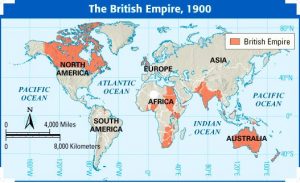 World wars are a complicated matter. There are multiple enemies, multiple allies, and the lines are not necessarily very clear. The one thing that always seems to be a constant, however, is territory. Imperialism…when a country takes over new lands or countries and makes them subject to their rule, played a big roll in World War I, as did industrialism. By 1900, any territorial gain by one power meant the loss of territory by another, and for Britain, the strongest of all the empires, that was a problem. Britain’s colonial territory was over 100 times the size of its own territory at home, thus giving rise to the phrase “the sun never sets on the British empire.” At this same time, France had control of large areas of Africa. With the rise of industrialism countries needed new markets. The amount of lands owned by Britain and France increased the rivalry with Germany who had entered the scramble to acquire colonies late and only had small areas of Africa.
World wars are a complicated matter. There are multiple enemies, multiple allies, and the lines are not necessarily very clear. The one thing that always seems to be a constant, however, is territory. Imperialism…when a country takes over new lands or countries and makes them subject to their rule, played a big roll in World War I, as did industrialism. By 1900, any territorial gain by one power meant the loss of territory by another, and for Britain, the strongest of all the empires, that was a problem. Britain’s colonial territory was over 100 times the size of its own territory at home, thus giving rise to the phrase “the sun never sets on the British empire.” At this same time, France had control of large areas of Africa. With the rise of industrialism countries needed new markets. The amount of lands owned by Britain and France increased the rivalry with Germany who had entered the scramble to acquire colonies late and only had small areas of Africa.
During this time Germany became concerned that Russia might try to take over their nation, so they signed a 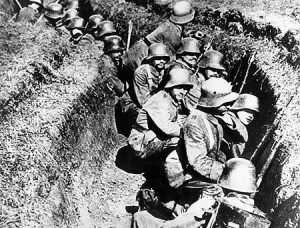 treaty with Austria-Hungary to protect each other from Russia. The Dual Alliance was created by treaty on October 7, 1879 as part of Bismarck’s system of alliances to prevent or limit war. The two powers promised each other support in case of attack by Russia. Also, each state promised benevolent neutrality to the other if one of them was attacked by another European power, most likely France. Germany’s Otto von Bismarck saw the alliance as a way to prevent the isolation of Germany and to preserve peace, as Russia would not wage war against both empires. Then in 1881, Austria-Hungary made an alliance with Serbia to stop Russia from gaining control of Serbia. Before long alliances were popping up everywhere. Germany and Austria-Hungary made an alliance with Italy in 1882 that was dubbed The Triple Alliance to stop Italy from taking sides with Russia. Then in 1894, Russia formed an alliance with France called the Franco-Russian Alliance, to protect Russia against Germany and Austria-Hungary.
treaty with Austria-Hungary to protect each other from Russia. The Dual Alliance was created by treaty on October 7, 1879 as part of Bismarck’s system of alliances to prevent or limit war. The two powers promised each other support in case of attack by Russia. Also, each state promised benevolent neutrality to the other if one of them was attacked by another European power, most likely France. Germany’s Otto von Bismarck saw the alliance as a way to prevent the isolation of Germany and to preserve peace, as Russia would not wage war against both empires. Then in 1881, Austria-Hungary made an alliance with Serbia to stop Russia from gaining control of Serbia. Before long alliances were popping up everywhere. Germany and Austria-Hungary made an alliance with Italy in 1882 that was dubbed The Triple Alliance to stop Italy from taking sides with Russia. Then in 1894, Russia formed an alliance with France called the Franco-Russian Alliance, to protect Russia against Germany and Austria-Hungary.
Now at this point, I’m sure you feel as confused about all this as I did. To me, it seems like it would be very difficult to know who the enemy really was, and even if you knew, it was subject to change, depending on who they formed an alliance with. That is also why I was wondering why on June 16, 1918, the Battle of the Piave River was raging on the Italian front. Russia had bowed out of the war effort in early 1918, and Germany began 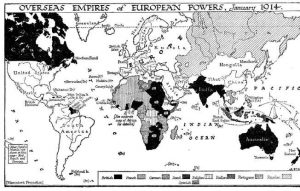 to pressure its ally, Austria-Hungary, to devote more resources to combating Italy. Wait…I thought Italy was their ally…apparently not so much. Specifically, the Germans wanted a major new offensive along the Piave River, located just a few kilometers from such important Italian urban centers as Venice, Padua and Verona. In addition to striking on the heels of Russia’s withdrawal, the offensive was intended as a follow-up to the spectacular success of the German-aided operations at Caporetto in the autumn of 1917. Wars really seem to be quite senseless, but when Imperialistic nations try to expand their territories, I guess, alliances can be made and broken quite easily.
to pressure its ally, Austria-Hungary, to devote more resources to combating Italy. Wait…I thought Italy was their ally…apparently not so much. Specifically, the Germans wanted a major new offensive along the Piave River, located just a few kilometers from such important Italian urban centers as Venice, Padua and Verona. In addition to striking on the heels of Russia’s withdrawal, the offensive was intended as a follow-up to the spectacular success of the German-aided operations at Caporetto in the autumn of 1917. Wars really seem to be quite senseless, but when Imperialistic nations try to expand their territories, I guess, alliances can be made and broken quite easily.
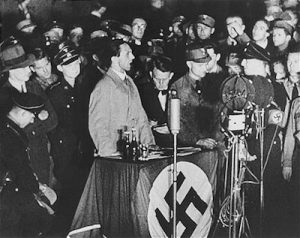 One of the best ways to form a dictatorship is to suppress knowledge. That’s one reason that propaganda is so important. When the people only hear what the government wants them to, they tend to become compliant…or at least that’s the theory. When Adolf Hitler was elected to office, he was the people’s choice, but they had no idea just how evil he was and how long they would be stuck with him. With the end of democracy, Germany became a one-party dictatorship. The Nazis began a massive propaganda campaign to win the loyalty and cooperation of Germans. The Nazi Propaganda Ministry, directed by Dr Joseph Goebbels, took control of all forms of communication in Germany…newspapers, magazines, books, public meetings, and rallies, art, music, movies, and radio. Viewpoints in any way threatening to Nazi beliefs or to the regime were censored or eliminated from all media. The German people were isolated from the outside world, and while they did not like it, the government became their only source of information.
One of the best ways to form a dictatorship is to suppress knowledge. That’s one reason that propaganda is so important. When the people only hear what the government wants them to, they tend to become compliant…or at least that’s the theory. When Adolf Hitler was elected to office, he was the people’s choice, but they had no idea just how evil he was and how long they would be stuck with him. With the end of democracy, Germany became a one-party dictatorship. The Nazis began a massive propaganda campaign to win the loyalty and cooperation of Germans. The Nazi Propaganda Ministry, directed by Dr Joseph Goebbels, took control of all forms of communication in Germany…newspapers, magazines, books, public meetings, and rallies, art, music, movies, and radio. Viewpoints in any way threatening to Nazi beliefs or to the regime were censored or eliminated from all media. The German people were isolated from the outside world, and while they did not like it, the government became their only source of information.
Germany was now led by a self-educated, high school drop-out named Adolf Hitler, who was by nature strongly anti-intellectual. For Hitler, the reawakening of the long-dormant Germanic spirit, with its racial and militaristic  qualities, was far more important than any traditional notions of learning. Books and writings by such authors as Henri Barbusse, Franz Boas, John Dos Passos, Albert Einstein, Lion Feuchtwanger, Friedrich Förster, Sigmund Freud, John Galsworthy, André Gide, Ernst Glaeser, Maxim Gorki, Werner Hegemann, Ernest Hemingway, Erich Kästner, Helen Keller, Alfred Kerr, Jack London, Emil Ludwig, Heinrich Mann, Thomas Mann, Karl Marx, Hugo Preuss, Marcel Proust, Erich Maria Remarque, Walther Rathenau, Margaret Sanger, Arthur Schnitzler, Upton Sinclair, Kurt Tucholsky, Jakob Wassermann, H.G. Wells, Theodor Wolff, Emilé Zola, Arnold Zweig, and Stefan Zweig, were suddenly unGerman. Their books were pulled from libraries and schools. Then, on the night of May 10, 1933, an event unseen in Europe since the Middle Ages occurred as German students from universities once regarded as among the finest in the world, gathered in Berlin to burn books with unGerman ideas. It was the Nazi burning of knowledge. Students can be very impressionable, and easily lead, and these students played right into Hitler’s hand.
qualities, was far more important than any traditional notions of learning. Books and writings by such authors as Henri Barbusse, Franz Boas, John Dos Passos, Albert Einstein, Lion Feuchtwanger, Friedrich Förster, Sigmund Freud, John Galsworthy, André Gide, Ernst Glaeser, Maxim Gorki, Werner Hegemann, Ernest Hemingway, Erich Kästner, Helen Keller, Alfred Kerr, Jack London, Emil Ludwig, Heinrich Mann, Thomas Mann, Karl Marx, Hugo Preuss, Marcel Proust, Erich Maria Remarque, Walther Rathenau, Margaret Sanger, Arthur Schnitzler, Upton Sinclair, Kurt Tucholsky, Jakob Wassermann, H.G. Wells, Theodor Wolff, Emilé Zola, Arnold Zweig, and Stefan Zweig, were suddenly unGerman. Their books were pulled from libraries and schools. Then, on the night of May 10, 1933, an event unseen in Europe since the Middle Ages occurred as German students from universities once regarded as among the finest in the world, gathered in Berlin to burn books with unGerman ideas. It was the Nazi burning of knowledge. Students can be very impressionable, and easily lead, and these students played right into Hitler’s hand.
The youth-oriented Nazi movement had always attracted a sizable following among university students. Even back in the 1920s they thought Nazism was the wave of the future. They joined the National Socialist 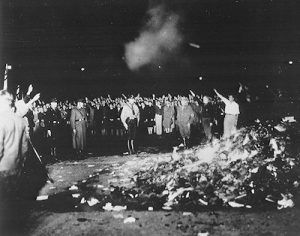 German Students’ League, put on swastika armbands and harassed anti-Nazi teachers. Many formerly reluctant professors were swept along by the outpouring of student enthusiasm that followed Hitler’s seizure of power. Most of the professors eagerly surrendered their intellectual honesty and took the required Nazi oath of allegiance. They also wanted to curry favor with Nazi Party officials in order to grab one of the academic vacancies resulting from the mass expulsion of Jewish professors and deans. The entire education system of a nation changed…almost overnight. As the German-Jewish poet, Heinrich Heine, had declared, a hundred years before the advent of Hitler, “Wherever books are burned, human beings are destined to be burned too.” And so it was in the end.
German Students’ League, put on swastika armbands and harassed anti-Nazi teachers. Many formerly reluctant professors were swept along by the outpouring of student enthusiasm that followed Hitler’s seizure of power. Most of the professors eagerly surrendered their intellectual honesty and took the required Nazi oath of allegiance. They also wanted to curry favor with Nazi Party officials in order to grab one of the academic vacancies resulting from the mass expulsion of Jewish professors and deans. The entire education system of a nation changed…almost overnight. As the German-Jewish poet, Heinrich Heine, had declared, a hundred years before the advent of Hitler, “Wherever books are burned, human beings are destined to be burned too.” And so it was in the end.
 Every war has one thing in common…there are two opposing sides. That can make for a volatile situation, even years after the war is over. Take our own Civil War. That war ended in 1865, but to this day, there are those who think we should tear down any and all memorials to the heroes of the South, which of course, lost the war. It’s a tough situation, but when you think about it, is a general from the South any less brave in battle. It is all a part of he fabric that forms our nation. They did not win the war, but as we have all told our children about sports, “It’s not whether you win or lose, but how you played the game.” Now, I know that war isn’t a game, although some have indicated that it is, nevertheless, most soldiers from the South fought as bravely and as honorably as those from the north. Everyone knows that the Confederate flag is not the flag of the United States, but it is a piece of it’s history, and history is history. It is not something we should be defacing, but rather honoring, because the fought the good fight.
Every war has one thing in common…there are two opposing sides. That can make for a volatile situation, even years after the war is over. Take our own Civil War. That war ended in 1865, but to this day, there are those who think we should tear down any and all memorials to the heroes of the South, which of course, lost the war. It’s a tough situation, but when you think about it, is a general from the South any less brave in battle. It is all a part of he fabric that forms our nation. They did not win the war, but as we have all told our children about sports, “It’s not whether you win or lose, but how you played the game.” Now, I know that war isn’t a game, although some have indicated that it is, nevertheless, most soldiers from the South fought as bravely and as honorably as those from the north. Everyone knows that the Confederate flag is not the flag of the United States, but it is a piece of it’s history, and history is history. It is not something we should be defacing, but rather honoring, because the fought the good fight.
President Regan felt the same way when he visited Germany on May 5, 1985. The Holocaust was a horrible 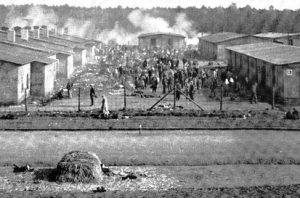 event, and not one that the majority of the German people agreed with, but they were in a difficult place too. They were following orders. Had they not done so, they would have been killed…here was no doubt. So, when Reagan went to Germany and to the cemeteries of the fallen German soldiers, should he have been disrespectful…of course not. He was a visitor in their country, and whether their politics was right or wrong, these were their fallen heroes. They were fathers, sons, brothers, uncles, grandfathers to someone in Germany, and they were loved. As Reagan said that day, “Here they lie. Never to hope. Never to pray. Never to love. Never to heal. Never to laugh. Never to cry.” Lives taken…too soon, by war, and that made them a nation’s heroes.
event, and not one that the majority of the German people agreed with, but they were in a difficult place too. They were following orders. Had they not done so, they would have been killed…here was no doubt. So, when Reagan went to Germany and to the cemeteries of the fallen German soldiers, should he have been disrespectful…of course not. He was a visitor in their country, and whether their politics was right or wrong, these were their fallen heroes. They were fathers, sons, brothers, uncles, grandfathers to someone in Germany, and they were loved. As Reagan said that day, “Here they lie. Never to hope. Never to pray. Never to love. Never to heal. Never to laugh. Never to cry.” Lives taken…too soon, by war, and that made them a nation’s heroes.
No two sides will ever agree, and emotions run high after a war, but sometimes people take things too far…retaliating for things they believe were wrong, years and even centuries after the events took place. The dead  are dead, and their memorials should be left alone, whether they are private, state, or national. To someone, somewhere, their efforts were heroic, and just because we have a different view of the things they stood for, does not give is the right to terrorize their graves and memorials. I suppose that many people would argue this point with me, and let it be known that I am not condoning the wrongs done by evil nations, I an simply saying that we should leave the memorials alone, because they do no harm. If people want to make a statement, they should teach their children right from wrong, so that they understand the difference between a cause, and a heroic soldier of that cause. One could arguably be condemned, while the other should not be.
are dead, and their memorials should be left alone, whether they are private, state, or national. To someone, somewhere, their efforts were heroic, and just because we have a different view of the things they stood for, does not give is the right to terrorize their graves and memorials. I suppose that many people would argue this point with me, and let it be known that I am not condoning the wrongs done by evil nations, I an simply saying that we should leave the memorials alone, because they do no harm. If people want to make a statement, they should teach their children right from wrong, so that they understand the difference between a cause, and a heroic soldier of that cause. One could arguably be condemned, while the other should not be.
 While Germany was willing to go to war, they had, nevertheless, a healthy fear of the United States. During World War I, Germany introduced unrestricted submarine warfare. It was early 1915, and Germany decided that the area around the British Isles was a war zone, and all merchant ships, including those from neutral countries, would be attacked by the German navy. That action set in motion a series of attacks on merchant ships, that finally led to the sinking of the British passenger ship, RMS Lusitania on May 7, 1915. It was at this point that President Woodrow Wilson decided that it was time to pressure the German government to curb their naval actions. Because the German government didn’t want to antagonize the United States, they agreed to put restrictions on the submarine policy going forward, which angered many of their naval leaders, including the naval commander in chief, Admiral Alfred von Tirpitz, who showed his frustration by resigning in March 1916.
While Germany was willing to go to war, they had, nevertheless, a healthy fear of the United States. During World War I, Germany introduced unrestricted submarine warfare. It was early 1915, and Germany decided that the area around the British Isles was a war zone, and all merchant ships, including those from neutral countries, would be attacked by the German navy. That action set in motion a series of attacks on merchant ships, that finally led to the sinking of the British passenger ship, RMS Lusitania on May 7, 1915. It was at this point that President Woodrow Wilson decided that it was time to pressure the German government to curb their naval actions. Because the German government didn’t want to antagonize the United States, they agreed to put restrictions on the submarine policy going forward, which angered many of their naval leaders, including the naval commander in chief, Admiral Alfred von Tirpitz, who showed his frustration by resigning in March 1916.
On March 24, 1916, soon after Tirpitz’s resignation, a German U-boat submarine attacked the French passenger steamer Sussex, in the English Channel, thinking it was a British ship equipped to lay explosive mines. It was apparently an honest mistake, and the ship did not sink. Still, 50 people were killed and many 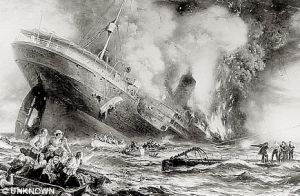 more injured, including several Americans. On April 19, in an address to the United States Congress, President Wilson took a firm stance, stating that unless the Imperial German Government agreed to immediately abandon its present methods of warfare against passenger and freight carrying vessels the United States would have no choice but to sever diplomatic relations with the Government of the German Empire altogether.
more injured, including several Americans. On April 19, in an address to the United States Congress, President Wilson took a firm stance, stating that unless the Imperial German Government agreed to immediately abandon its present methods of warfare against passenger and freight carrying vessels the United States would have no choice but to sever diplomatic relations with the Government of the German Empire altogether.
After Wilson’s speech, the US ambassador to Germany, James W. Gerard, spoke directly to Kaiser Wilhelm on May 1 at the German army headquarters at Charleville in eastern France. After Gerard protested the continued German submarine attacks on merchant ships, the Kaiser in turn denounced the American government’s compliance with the Allied naval blockade of Germany, in place since late 1914. Nevertheless, Germany could not risk American entry into the war against them, so when Gerard urged the Kaiser to provide assurances of a change in the submarine policy, the Kaiser agreed.
On May 6, the German government signed the so-called Sussex Pledge, promising to stop the indiscriminate sinking of non-military ships. According to the pledge, merchant ships would be searched, and sunk only if they 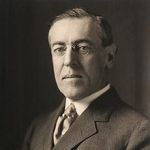 were found to be carrying contraband materials. Furthermore, no ship would be sunk before safe passage had been provided for the ship’s crew and its passengers. Gerard was skeptical of the intentions of the Germans, and wrote in a letter to the United States State Department that “German leaders, forced by public opinion, and by the von Tirpitz and Conservative parties would take up ruthless submarine warfare again, possibly in the autumn, but at any rate about February or March, 1917.” Gerard was right, and on February 1, 1917, Germany announced the resumption of unrestricted submarine warfare. Two days later, Wilson announced a break in diplomatic relations with the German government, and on April 6, 1917, the United States formally entered World War I on the side of the Allies.
were found to be carrying contraband materials. Furthermore, no ship would be sunk before safe passage had been provided for the ship’s crew and its passengers. Gerard was skeptical of the intentions of the Germans, and wrote in a letter to the United States State Department that “German leaders, forced by public opinion, and by the von Tirpitz and Conservative parties would take up ruthless submarine warfare again, possibly in the autumn, but at any rate about February or March, 1917.” Gerard was right, and on February 1, 1917, Germany announced the resumption of unrestricted submarine warfare. Two days later, Wilson announced a break in diplomatic relations with the German government, and on April 6, 1917, the United States formally entered World War I on the side of the Allies.
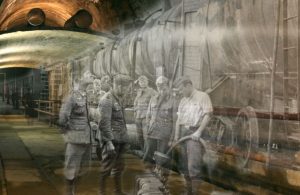
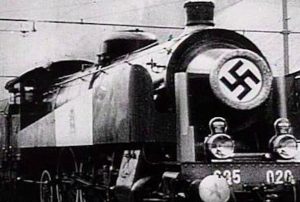 So much is still unknown about the things that Adolf Hitler did, including an apparent “Ghost Train” that was filled with gold and other treasures. According to legend, as the Soviet forces approached in the final days of World War II, an armored train left the city of Breslau (now Wroclaw, Poland) in April 1945 and headed west toward Waldenburg (now Walbrzych). Somewhere along the 40 mile trip, the train and its cargo of gold and other treasures…many of them stolen by the Nazis from Jewish families…vanished into the Owl Mountains, never to be seen again, except in local legend. Stories of the Nazi “Ghost Train” date back some 70 years, although historians haven’t been able to conclusively prove the train ever existed. During the war, Hitler ordered the creation of a network of underground tunnels in the Owl Mountains, which at the time were under German control, as part of a project known as “Riese,” meaning “Giant.” The original rumor of a Nazi train hidden in the mountains came from a Polish miner, who claimed that just after the war, German miners told him they had seen the train being pushed into one of the tunnels.
So much is still unknown about the things that Adolf Hitler did, including an apparent “Ghost Train” that was filled with gold and other treasures. According to legend, as the Soviet forces approached in the final days of World War II, an armored train left the city of Breslau (now Wroclaw, Poland) in April 1945 and headed west toward Waldenburg (now Walbrzych). Somewhere along the 40 mile trip, the train and its cargo of gold and other treasures…many of them stolen by the Nazis from Jewish families…vanished into the Owl Mountains, never to be seen again, except in local legend. Stories of the Nazi “Ghost Train” date back some 70 years, although historians haven’t been able to conclusively prove the train ever existed. During the war, Hitler ordered the creation of a network of underground tunnels in the Owl Mountains, which at the time were under German control, as part of a project known as “Riese,” meaning “Giant.” The original rumor of a Nazi train hidden in the mountains came from a Polish miner, who claimed that just after the war, German miners told him they had seen the train being pushed into one of the tunnels.
In 2015, two anonymous men contacted officials in Walbrzych, a district in southwestern Poland, claiming to know the train’s location and demanding 10 percent of the value of its contents in exchange for leading authorities there. According to Marika Tokarska, an official in the southwestern Polish district of Walbrzych, a law firm representing two men…a Pole and a German, who prefer to remain anonymous…sent her office two letters, offering a description of the train and its contents and claiming to know its location. The documents received from the law firm claim the train is some 490 feet long and loaded with guns, precious metals and other valuables, including up to 300 tons of gold. In exchange for revealing the train’s location, the men are demanding 10 percent of the value of its contents. Although there is much skepticism expressed by historians as to the validity of the men’s claims, authorities in Walbrzych say they will pay the reward if the information turns out to be legitimate. I guess I would too. The men are asking 10% of the total, which could be a huge amount, but not nearly as much as the remaining 90%, so paying them would make sense. As Tokarska told the Associated Press: “We believe that a train has been found. We are taking this information seriously.” Though the men’s knowledge of the train’s contents and their retaining of a lawyer lend legitimacy to their claims, there is still plenty room for skepticism: The first letter from the men’s law firm included several references to local topography suggesting the men might not be as familiar with the area as they claim, and previous searches for the train in recent years have yielded nothing.
Andreas Richter, a German, and Piotr Koper, a Pole, moved in with heavy equipment and dug deep at a site near rail tracks in Walbrzych, following comments by residents who said they had knowledge of the train’s 
 existence. Richter and Koper said that their own tests using earth-penetrating radar confirmed a train was at the site. Nevertheless, after an initial dig, the crew turned up no sign of the “Ghost Train.” Still, they have not given up just yet. There are plans in place to dig again in the very near future. The two men are determined to prove that they have found the real “Ghost Train,” and to claim the 10% share they were promised, it they find it.
existence. Richter and Koper said that their own tests using earth-penetrating radar confirmed a train was at the site. Nevertheless, after an initial dig, the crew turned up no sign of the “Ghost Train.” Still, they have not given up just yet. There are plans in place to dig again in the very near future. The two men are determined to prove that they have found the real “Ghost Train,” and to claim the 10% share they were promised, it they find it.
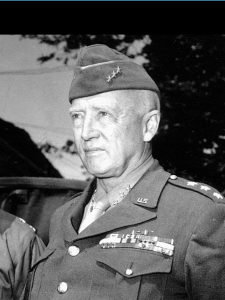 In many of the wars there have been in our world, one thing seems to be a constant…the atrocities against prisoners of war, and even the citizens of the evil nations we are fighting against. World War II probably saw some of the worst atrocities, during the Holocaust. It was during that time that prison camps like Auschwitz-Birkenau, Buchenwald, Chelmno, Dachau, and Terezin, just to name a few, were used either for the murder of Jews and anyone else Hitler felt was not of the standard of people he thought they should be, or the prisoners they held were used as forced labor.
In many of the wars there have been in our world, one thing seems to be a constant…the atrocities against prisoners of war, and even the citizens of the evil nations we are fighting against. World War II probably saw some of the worst atrocities, during the Holocaust. It was during that time that prison camps like Auschwitz-Birkenau, Buchenwald, Chelmno, Dachau, and Terezin, just to name a few, were used either for the murder of Jews and anyone else Hitler felt was not of the standard of people he thought they should be, or the prisoners they held were used as forced labor.
Buchenwald was not an Annihilation camp, but that doesn’t mean that it was a easy existence. The Germans were not good to their prisoners. Prisoners from all over Europe and the Soviet Union…Jews, Poles and other Slavs, the mentally ill and physically-disabled from birth defects, religious and political prisoners, Roma and Sinti, Freemasons, Jehovah’s Witnesses (then called Bible Students), criminals, homosexuals, and prisoners of war, worked primarily as forced labor in local armaments factories. It seems as if there were no groups who were exempt. If they didn’t fit into Hitler’s mold, they were contained in the camps, or killed. Buchenwald concentration camp (German: Konzentrationslager, which in English, literally means beech forest) was a German Nazi concentration camp established on the Ettersberg (Etter Mountain) near Weimar, Germany, in July 1937. It was one of the first and the largest of the concentration camps on German soil, following Dachau’s opening just over four years earlier.
On April 11, 1945, four soldiers in the Sixth Armored Division of the US Third Army, commanded by General 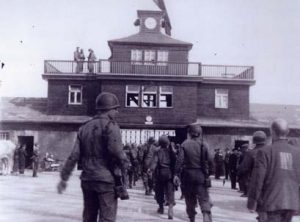 George S Patton, liberated the Buchenwald concentration camp. Just before the Americans arrived, the camp had already been taken over by the Communist prisoners who had killed some of the guards and forced the rest to flee into the nearby woods. They knew the end was near for them anyway, and there seemed no further reason to stand and fight. I suppose that the fact that the guards had deserted their posts, made it possible for just four soldiers to take over and liberate the camp. On the morning of April 12, 1945, soldiers of the 80th Infantry Division arrived in the nearby town of Weimar and found it deserted except for some of the liberated prisoners roaming around. The townspeople were cowering in fear inside their homes…bomb-damaged from the February 9, 1945 air raid that was to precede the liberation process. I would think that if any of them were a part of the concentration camp, there would be reason to fear the prisoners in town, because they had a reason to kill them, after all they had been through in German custody.
George S Patton, liberated the Buchenwald concentration camp. Just before the Americans arrived, the camp had already been taken over by the Communist prisoners who had killed some of the guards and forced the rest to flee into the nearby woods. They knew the end was near for them anyway, and there seemed no further reason to stand and fight. I suppose that the fact that the guards had deserted their posts, made it possible for just four soldiers to take over and liberate the camp. On the morning of April 12, 1945, soldiers of the 80th Infantry Division arrived in the nearby town of Weimar and found it deserted except for some of the liberated prisoners roaming around. The townspeople were cowering in fear inside their homes…bomb-damaged from the February 9, 1945 air raid that was to precede the liberation process. I would think that if any of them were a part of the concentration camp, there would be reason to fear the prisoners in town, because they had a reason to kill them, after all they had been through in German custody.
Recently, I found out that General George S Patton was my 8th cousin twice removed, on my grandmother, Hattie Pattan Byer’s side. I had always suspected a relationship there, with my grandmother’s maiden name being Pattan, but I didn’t expect it in the way it came about, since it is from my grandmother Elizabeth Shuck, who married my grandfather David Pattan, and not from the Pattan side outright. I have always liked General 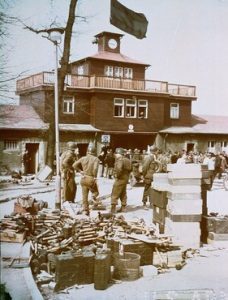 Patton, and I think it is really awesome that he is related to my family. In my opinion, he was an amazing general. He served as a commissioned officer in the United States Army for 36 years. He served in three major conflicts (Mexican Punitive Expedition, World War I and World War II) during his military career. He was awarded with the Distinguished Service Cross with one oak leaf cluster, the Army Distinguished Service Medal with two oak leaf clusters, the Navy Distinguished Service Medal, the Silver Star with one oak leaf cluster, the Legion of Merit, the Bronze Star Medal, the Purple Heart, the Silver Lifesaving Medal, the Mexican Border Service Medal, the World War I Victory Medal with four bronze campaign stars, the American Defense Service Medal, the European-African-Middle Eastern Campaign Medal with one silver and two bronze campaign star, the World War II Victory Medal, and posthumously…the Army of Occupation Medal with Germany clasp. That’s quite a war record. I’m sure the prisoners that he liberated felt that he very much earned them for his war skills.
Patton, and I think it is really awesome that he is related to my family. In my opinion, he was an amazing general. He served as a commissioned officer in the United States Army for 36 years. He served in three major conflicts (Mexican Punitive Expedition, World War I and World War II) during his military career. He was awarded with the Distinguished Service Cross with one oak leaf cluster, the Army Distinguished Service Medal with two oak leaf clusters, the Navy Distinguished Service Medal, the Silver Star with one oak leaf cluster, the Legion of Merit, the Bronze Star Medal, the Purple Heart, the Silver Lifesaving Medal, the Mexican Border Service Medal, the World War I Victory Medal with four bronze campaign stars, the American Defense Service Medal, the European-African-Middle Eastern Campaign Medal with one silver and two bronze campaign star, the World War II Victory Medal, and posthumously…the Army of Occupation Medal with Germany clasp. That’s quite a war record. I’m sure the prisoners that he liberated felt that he very much earned them for his war skills.

